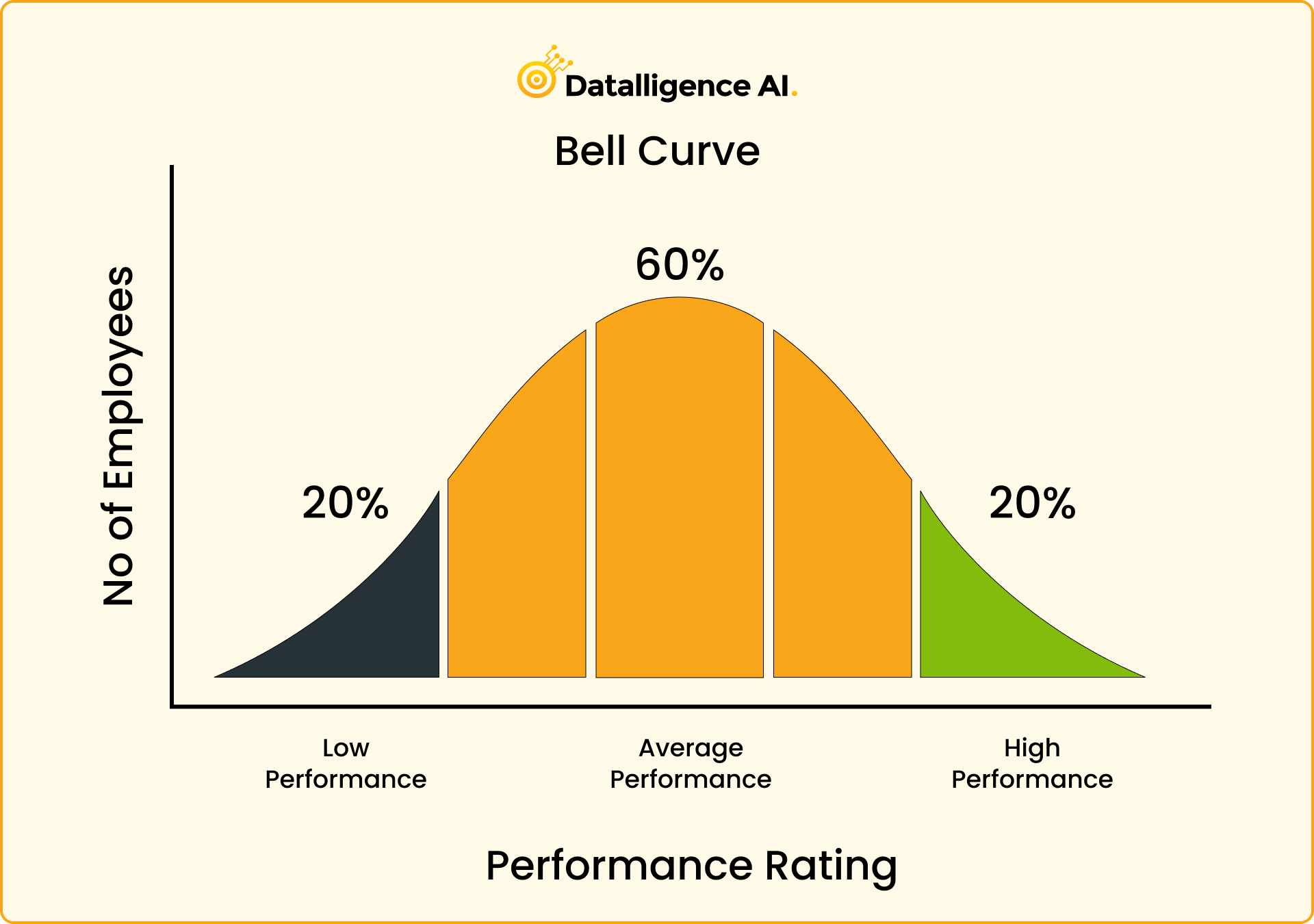In the ever-changing landscape of the business world, performance management has become a critical focus for organizations aiming to drive growth and success. Traditionally, the bell curve approach has been used to evaluate employee performance, categorizing individuals into below-average, average, and excellent performers.
However, as the demands of modern workplaces evolve, questions arise about the relevance and effectiveness of this traditional approach. In this article, we will explore the limitations of the bell curve method and discuss the need for a more comprehensive and growth-centric performance management system.
In the era of dynamic business dynamics, the paradigm of performance management is undergoing a seismic shift. The conventional bell curve method, once the cornerstone of employee evaluation, faces scrutiny for its limitations. This article delves into the challenges associated with the bell curve percentages, dissecting the traditional Performance Management Bell Curve and Performance Review systems. As organizations strive for growth, we explore the imperative to embrace a more holistic, growth-centric approach to performance management

Table of Contents
Understanding the Bell Curve Approach
The performance management bell curve is a statistical model that categorizes employee performance into three major groups: below average, average, and excellent. This system assumes that most employees fall within the average category, with a smaller percentage classified as below-average or excellent performers. The bell curve is named after its shape, which resembles a bell.
The purpose of the bell curve is to compare employee performance relative to one another and identify areas for improvement or intervention. It also allows organizations to assess the impact of training and development programs. However, the relevance and effectiveness of the bell curve in today's hypergrowth environment have come under scrutiny.
Limitations of the Bell Curve Approach
Although the bell curve approach has been widely used in performance management, it has several limitations that make it less effective in today's hypergrowth environments. One major drawback is the competitive environment it fosters among employees. The focus on categorizing employees and ranking them against one another can create a sense of rivalry and discourage collaboration.
Furthermore, the bell curve approach fails to consider individual circumstances and differences. It does not account for external factors that may affect an employee's performance, such as personal issues or temporary setbacks. This lack of flexibility can lead to unfair evaluations and demotivate employees.
Another limitation is the lack of focus on employee development and growth. Once an employee is placed in a specific category, there is limited room for improvement or advancement. This can result in stagnation and disengagement among employees.
The Need for a Growth-Centric Approach
In today's hypergrowth environments, organizations require a performance management system that promotes continuous development and empowers employees to reach their full potential. Instead of focusing solely on categorizing employees, a growth-centric approach emphasizes individual growth, skill development, and collaboration.
One alternative to the bell curve approach is a continuous feedback and coaching model. This model emphasizes regular feedback discussions and coaching sessions to provide employees with real-time guidance and support. It allows for ongoing performance discussions, enabling employees to address challenges and set goals for growth.
Another approach is goal-oriented performance management, where employees and managers set clear, measurable goals aligned with organizational objectives. Regular check-ins and progress updates ensure continuous alignment and provide opportunities for feedback and course correction.
Leveraging Data and Technology
To support a growth-centric approach to performance management, organizations can leverage data and technology to gather valuable insights and facilitate ongoing feedback. Real-time performance tracking systems, automated performance analysis, and data-driven evaluations provide a more accurate and objective assessment of employee performance.
By collecting and analyzing data on an ongoing basis, organizations can identify patterns, strengths, and areas for improvement. This data-driven approach enables targeted interventions and personalized development plans, fostering employee growth and engagement.
Emphasizing Holistic Evaluations and Team Performance
In a growth-centric approach, the focus shifts from individual performance to holistic evaluations and team performance. Recognizing the importance of collaboration and teamwork, organizations assess not only individual contributions but also the collective achievements of teams.
By fostering a collaborative culture and recognizing the value of diverse skills and perspectives, organizations can drive innovation and improve overall team productivity. This shift in focus encourages employees to work together toward shared objectives and fosters a supportive and engaged work environment.
Customizing Performance Management Approaches
While there is no one-size-fits-all solution to performance management, organizations can tailor their approaches to align with their unique needs and culture. Some companies may combine different methods, such as goal-oriented performance management for sales teams and continuous feedback models for other functions or business units.
The key is to prioritize employee development, ongoing feedback, and collaboration while leveraging data and technology to support performance evaluations. Organizations can create a system that promotes growth, engagement, and success by customizing performance management approaches.
The Role of Datalligence.ai in Modern Performance Management
At Datalligence.ai, we understand the evolving landscape of performance management and the need for a growth-centric approach. We provide cutting-edge technology solutions that enable organizations to streamline performance evaluations, gather real-time insights, and foster employee development.
Our AI-powered performance management platform empowers organizations to leverage data-driven evaluations, continuous feedback, and personalized development plans. By combining the latest technology with a focus on employee growth, we help organizations create a performance management system that drives success in today's hypergrowth environments.
With Datalligence.ai, organizations can reimagine their performance management strategies, move away from outdated approaches like the bell curve, and embrace a growth-centric approach that promotes collaboration, development, and employee engagement.
Conclusion
As the business landscape continues to evolve, performance management approaches must adapt to meet the demands of modern organizations. The traditional bell curve approach, while once popular, has proven to be limiting and ineffective in today's hypergrowth environments. By shifting to a growth-centric approach that emphasizes continuous feedback, personalized development plans, and team performance, organizations can create a more engaging and effective performance management system.
At Datalligence.ai, we are committed to revolutionizing performance management through our AI-powered platform. With our technology solutions, organizations can leverage data-driven insights, continuous feedback, and personalized development plans to drive growth, engagement, and success. Say goodbye to the outdated bell curve approach and embrace a performance management system that empowers your workforce and propels your organization forward.











